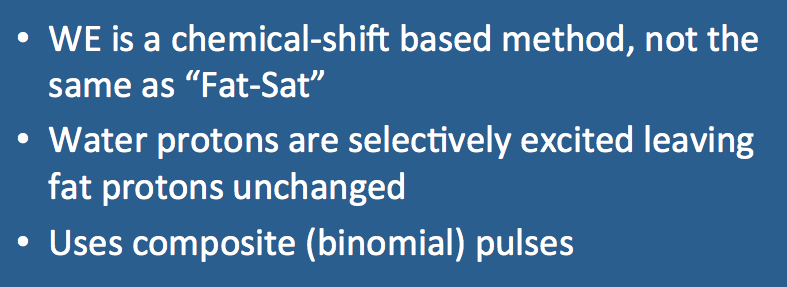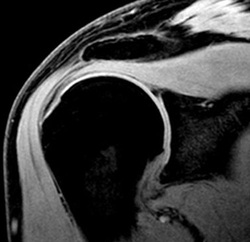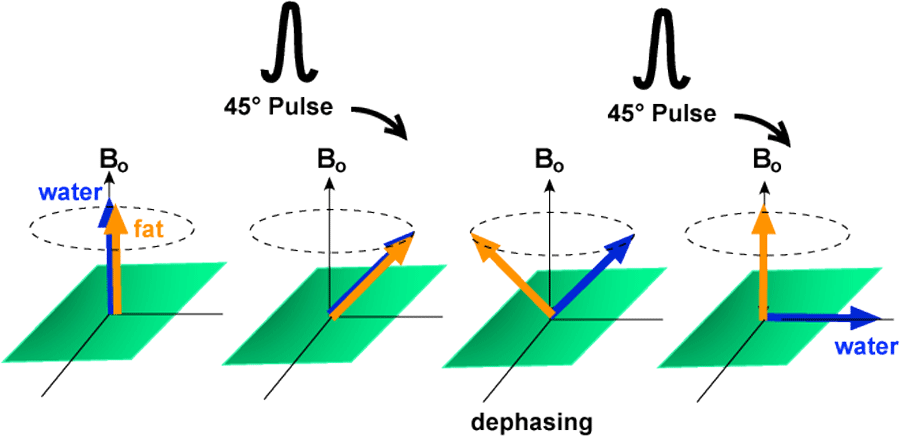|
Selective Water Excitation (WE) is different than Fat-Sat, although they are both based around the use of chemically selective RF-pulses. In Fat-Sat, fat protons are selectively excited and then dephased with a spoiler gradient. In WE, fat protons are left alone and water protons are selectively stimulated for image generation. No spoilers are used. The two methods are compared below.
|
|
The 45º-45º pulse pair described above is the simplest in a class of composite pulses known as binomial pulses. Binomial pulses have flip angles that follow the pattern of coefficients of the binomial expansion of (a+b)n: 1-1, 1-2-1, 1-3-3-1, etc. Thus, a 90º-pulse could be constructed as a [45º-45º] pair, a [22.5º-45º-22.5º] triplet, or a [11.25º-33.75º-33.75º-11.25º] quadruplet. Any combination whose ratios follow the binomial pattern and add up to 90º will work to selectively excite water and leave the fat resonance unchanged. |
Advanced Discussion (show/hide)»
Additional Notes on Selective Excitation Pulses
In addition to their conventional Water Excitation Technique (WET), Toshiba also offers a second method named PASTA (Polarity-Altered Spectral and spaTial Acquisition). PASTA combines chemical shift selective excitation as part of a spin-echo pulse sequence acquisition with both 90°- and 180°-pulses and a gradient reversal. Details can be found in the reference below.
PASTA is actually a modification of a relatively common method of fat suppression in the 1980's known as slice-selective gradient reversal (SSGR). In this clever technique, an accentuated chemical shift misregistration in the slice-select direction was first induced by using a narrow-bandwidth 90°-RF pulse in conjunction with a reduced strength of slice-select gradient. The slice-select gradient was then activated with reversed polarity at the time of the 180°-pulse. Because fat protons were shifted out of the slice in different directions between the 90°- and 180°-pulses, only water protons were stimulated by both the 90°- and 180°-pulses. Fat protons were chemically shifted so that they received either the 90°- or 180°-pulses, but not both.
A somewhat different approach to water excitation can be found in the RODEO (ROtating Delivery of Excitation Off resonance) technique, a method developed for contrast-enhanced breast imaging in the 1990's. RODEO is 3D rapid gradient echo sequence that produces T1-weighted images from a refocused FID. The sequence begins with a closely-spaced pair of phase-opposed sinusoidal adiabatic pulses tuned to the fat resonance. These pulses first invert and then restore fat magnetization, leaving fat magnetization unaffected and remaining along the z-direction. Meanwhile, off-resonance effects of these RF-pulses are sufficient to stimulate water protons and maintain their coherence in the transverse (xy)-plane for generation of a steady-state signal. The RODEO technique can also be used to suppress water or silicone by appropriate frequency and timing adjustments. To my knowledge RODEO is seldom used today, being provided only by one major brand of scanner, the Aurora® Dedicated Breast MRI System.
Selective excitation methods can be applied to specifically excite other chemicals besides water, including fat, silicone, and even macromolecules like n-acetylaspartate (NAA).
The phase dispersion for pulses used for WE must be more rigorously controlled than those used for fat suppression. This is because the fat signal is purposely dephased by spoiler gradients immediately after stimulation. For water excitation, we need the phases to remain together. If non-composite pulses are chosen for WE, these are typically either Shinnar LeRoux (SLR) with minimum phase design or BURP (Band-selective, Uniform Response, Pure-phase) with a long pulse width. As described above, however, composite (binomial) pulses are typically used for this purpose in most modern clinical MR systems.
Hauger O, Dumont E, Chateil J, et al. Water excitation as an alternative to fat saturation in MR imaging: Preliminary results in musculoskeletal imaging. Radiology 2002; 224:657–663.
Harms SE, Flamig DP, Hesley KL et al. MR imaging of the breast with rotating delivery of excitation off resonance: clinical experience with pathologic correlation. Radiology 1993; 187:493-501. (The RODEO technique, see Advanced Discussion).
Harms SE, Jensen, Meiches MD, et al. Silicone-suppressed 3D MRI of the breast using rotating delivery of off-resonance excitation. J Comput Assist Tomogr 1995; 19:394-399. (See Advanced Discussion).
Hore PJ. A new method for water suppression in the proton NMR spectra of aqueous solutions. J Magn Reson 1983;54:539-542.
Levitt MH. Composite pulses. Prog NMR Spectrosc 1986;18:61-122.
Meyer CH, Pauly JM, Macovski A, Nishimura DG. Simultaneous spatial and spectral selective excitation. Magn Reson Med 1990; 15:287-304.
Miyazaki M, Kassai Y. MR imaging using nested pulse sequence involving IR pulse. US Patent # 6,850,793 B1, filed 2 Mar 1999. (Describes details of Toshiba's PASTA technique on pp 33-4; See Advanced Discussion)
How do Fat-Sat pulses work?




